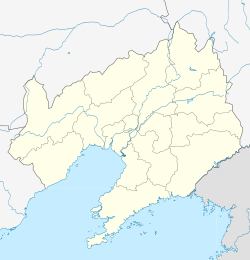Memorial of the War to Resist US Aggression and Aid Korea
抗美援朝纪念馆 | |
 Entrance to the museum, with a field gun in front | |
| Established | 1958 |
|---|---|
| Location | Dandong, Liaoning, China |
| Coordinates | 40°07′11″N 124°22′00″E / 40.1196°N 124.3668°E |
| Type | War museum |
| Website | www |
The Memorial Hall of the War to Resist US Aggression and Aid Korea (
History
The memorial is the only official museum about the Korean War in China. It was first established in 1958 as an annex of the local history museum of
The museum spent more than 10 years collecting all the names of the Chinese People's Volunteer Army soldiers killed in the war. In 2006, it announced that it had collected 183,108 names,[6] which has become an authoritative death count of Chinese soldiers in the Korean War. The museum plans to build a "martyrs' wall" inscribing the complete list of names.[6]
In 2008, the memorial was included in the first batch of 83
Location and facilities
The museum is located on Mount Yinghua north of downtown Dandong, overlooking the North Korean city of Sinuiju across the Yalu River. It consists of three major structures: the main exhibition hall, a panoramic painting hall, and a memorial tower,[4] surrounded by a 50,000-square-metre (540,000 sq ft) park.[5] It occupies an area of 182,000 square metres (1,960,000 sq ft), with a total building floor area of 20,000 square metres (220,000 sq ft).[5]
Exhibitions
The exhibition in the main hall comprises more than 700 photographs and over 1,000 artifacts, as well as models, charts, paintings, and sculptures that explain the progress of the war.
The panoramic painting hall contains a giant painting depicting the Battle of the Ch'ongch'on River (1950), a decisive victory by the People's Volunteer Army. Measuring 132.15 metres (433.6 ft) long and 16 metres (52 ft) high, it was China's largest panoramic painting when the museum opened in 1993.[5] The painting encircles a revolving viewing platform in the centre of the hall.[4]
The memorial tower is 53 metres (174 ft) tall, which signifies the year 1953, when the Korean Armistice Agreement was signed. The tower's name is written in the calligraphy of Deng Xiaoping.[5]
References
- ISBN 978-1-84353-019-0.
- ^ a b "【辽宁】抗美援朝纪念馆新馆开馆" [Memorial Hall of the War to Resist US Aggression and Aid Korea is now reopened with new building]. www.chinamartyrs.gov.cn. 21 September 2020. Retrieved 7 October 2021.
- ^ ISBN 978-1-5381-1191-8.
- ^ a b c d "抗美援朝纪念馆". People's Daily (in Chinese). Retrieved 29 January 2018.
- ^ a b c d e "History of the museum" (in Chinese). Memorial for the War to Resist America and Aid Korea. Archived from the original on 30 January 2018. Retrieved 29 January 2018.
- ^ a b "丹东抗美援朝纪念馆奔走十余年 集183108烈士名单". Phoenix News (in Chinese). 17 April 2014.
- State Administration of Cultural Heritage. 20 June 2008.[permanent dead link]
- ^ "北京天文馆被降为国家二级博物馆". China News (in Chinese). 15 May 2013.


